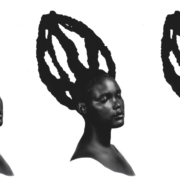How Gause’s Law explains elitism in the Arts

How Gause’s Law explains elitism in the Arts
Contribution by Chiraag Shah
Nilik Khimani is a 25-year-old multidisciplinary artist based in London. His creative practice spans a range of artistic mediums, from painting to performance art to poetry, and is determined largely by what he intends to communicate. In 2020, he made just under £500 from his creative outputs, despite having personal editorial features in global publications such as GQ and Verve India. I spoke with Nilik to see how he copes with the financial hardship that accompanies life as a freelance artist.
For early-career artists, freelance work is often notoriously underpaid. How do you cope financially?
Nilik: I’m not sure I do cope these days [but] I am getting by. For me, it’s mostly through budgeting. I’m aware that starting out can be tricky. However, it’s coming up to 4 years since I graduated, and I’m still unable to support myself and regularly take up supplementary jobs to fund my practice, as I get little to no paid opportunities.
How do you fund your practice and ensure that you’re able to continue producing work?
Nilik: A lot of my works are self-funded due to the lack of paid opportunities I have had. To create new work, you need to have an income, and so far, my largest sources of income have been positions that are not in the Arts. This enables me to keep creating my artistic outputs in the hopes that I won’t need to do such jobs one day, but it sure does feel like an extra-long shot, especially with the current circumstances.
Nilik’s experience is regrettably common: it embodies the social cliche of the “struggling artist.” In today’s age, it seems financial security is the cost one must pay in order to pursue a career in the Arts. The worry is that this sacrifice will lead to the Arts becoming viable career options only for those from wealthier backgrounds, who are better positioned to weather the four or five years of underpaid freelance work that precedes the “big career break.”
And yet, in popular culture, a different narrative is playing out. Here, the prevailing discourse surrounding the Arts, particularly music, is one of optimism – that we live in a time where anyone can make it, so long as they “hustle” hard enough. Indeed, “projects-to-riches” narratives pervade hip-hop, like in Drake’s auto-biographical Started From the Bottom and Jay-Z’s encomium to capitalist opportunism, Empire State of Mind. These songs are but two examples of an era that has set a precedent for the “making it out the ghetto” theme, which we now see so often in contemporary music. One genre which regularly engages with this theme is UK grime, where such narratives take centre-stage.
In Richer, Rod Waves talks about his journey from nothing to “Rollies and plaques” through the success of his music. Similarly, in Big B, D-Block narrates his journey from catching trains in Lewisham to flying out to 5-star hotels in Venice. And veteran listeners of the genre are likely to find motivation in Krept & Konan’s journey from playing football in South Norwood to spending $30,000 in Dior, as expressed in 2020 single; Self-Obsessed.
Due to the abundance of these narratives, and in others, to better accessibility and the sustained efforts of our parents to keep us ignorant of the labours of poverty, we might feel that we are better placed now to pursue our artistic passions professionally than previous generations. However, whilst opportunities to forge a secure career in the Arts may have become more accessible than perhaps they were before, we shouldn’t be entirely seduced by the narratives of contemporary music. For many young creatives, the low-paying nature of freelance work remains the sturdy iron gatekeeping them from achieving their artistic dreams.
Nilik, for example, is the only child of two first-generation immigrants. His mother was born in Gujarat, India and came to the UK with her family when she was only a year old, and his father was born in the UK after his grandparents had emigrated. Both were born into working-class families and grew up in an environment that prioritised financial security over pursuing one’s creative passions. For Nilik, the pressure and temptation to abandon freelance artistry to pursue a more secure and lucrative career path is often overwhelming. Like many before him, he too must consider whether he can bear the financial sacrifice of pursuing a career in the Arts and for how long.
Nilik: I’m an only child, and my parents are thinking about retirement. Both started working from the age of 16 and had multiple jobs to support my upbringing. I would love for them to not have to work much longer, but right now, I feel like I’m holding them back from retiring, which isn’t a great feeling at all. So yes, I often think I should have chosen a more stable career or at least one that pays and values my work and effort. We all know the creative industries aren’t favoured to produce long-term stable income sources, so it’s hard to stay motivated, and I’ve often thought of giving up.
Setting aside the pressure to support one’s parents, an annual wage of £500 is simply not enough for self-subsistence, let alone any hopes one might have to put down a deposit for a house or car. One solution to this problem may be to consider the issue on an institutional level by addressing both the perceived lack of support available to young prospective creatives and increasing the presence of young creatives in the industry. But with that said, fellowships and programmes specifically intended to give young creatives greater opportunities to kick-start their careers in the Arts are indeed available, whether in the form of junior internships, apprenticeships, or training programs.
If the feeling is that there is not enough support for young creatives, it may be because the Arts industry has become oversaturated with new, young talent in the past few decades, which has driven up the competition for these schemes. As Nilik states, “In our contemporary culture, the Arts have become more accessible, with more people applying to art schools and jobs in the industry. But with this accessibility comes a lot more competition. If you think about it, there [were] 70 of us in my undergraduate course, and that’s just one intake of students hoping to make it. With thousands of courses available, the competition increases every year. Now, going through art school doesn’t even help”.
The effect of this competition is unsurprisingly amplified for BAME creatives who are disproportionately disadvantaged by a lack of representation in the Arts industry. In recognition of this issue, London-based creative Adam Terrelonge endeavoured to create BlackLondonCreatives (BLC) in 2020. Inspired by Indiana Lawrence’s UK Database, BLC is a free directory for Black creatives in London. They can build a portfolio and be scouted by prospective employers. In doing so, it hopes to increase representation and opportunities for young Black creatives in the London Arts scene. The concept is also inspired in some part by Adam’s personal experiences as a creative.
Adam’s oeuvre spans a 9-year long career as a freelance musician, painter, and illustrator working in a multidisciplinary fashion. And yet, despite starting his creative journey from such a young age, he too received only £500 through client projects in 2020. Adam manages his finances by working as a full-time teacher, stating, “were I solely dependent on my artistic endeavors, I would be struggling financially.” For him, years of experience working in the freelance creative industry have revealed the challenges of working full-time as a freelance artist.
Asked if he has ever been tempted to abandon a career in the Arts in favour of a more lucrative career path, he responds,”I am fully aware that the work that I do cannot suitably support me. I have often found myself daydreaming of a time when I can take my artistic endeavors more seriously, but I understand the severe stress that comes with it. At the moment, I am working towards that”.
Many creatives like Adam have to resort to placing their creative interests on hold whilst gaining some financial stability from more reliable and better-paid career paths. To this end, BLC seeks to mitigate the shortage of well-paid work for Black artists by connecting them to potential employers. For Adam, connections are everything.
Adam: To make it in the industry, you have to know someone, be extremely lucky, talented, or create your own job. At the moment, the industry is dependent on who you know, and without nepotism at play, it is almost impossible for people to support themselves.
But where does Gause’s Law fit into all this? Laid out by Russian biologist and evolutionist Georgy Gause in the twentieth century, Gause’s Law, sometimes referred to as the competitive exclusion principle, is built on the idea of competition present in Charles Darwin’s theory of natural selection. It states that two species competing for the same limited resource cannot coexist. If one species has a competitive advantage over the other, it will dominate in the long term.
Perceiving the freelance creative job market in Gausian terms, that is, as a limited resource, it stands that competitive edges such as lower fees will naturally lead to an advantage. Combined with the over-saturated pool of talent, the issue that arises is that whilst a lower fee may be more desirable for prospective employers and may indeed lead to better chances at securing the job, it constrains the artist to sacrifice a liveable income for work.
Conversely, if the artist’s fee is too high, they may risk deterring employers who would instead opt for cheaper alternatives. Many young creatives trade high fees for exposure and experience, but the transaction is financially unsustainable.
As Nilik states, “experience and exposure are valuable, but not continually. Exposure doesn’t pay for resources and materials. Experience doesn’t put food on the table. [And] this is a frequent problem that most creatives face if [they] are not from a privileged background.
This is where the elitism comes in: trading one’s wages for experience is feasible only for artists from wealthier backgrounds who can afford to live and work without a reasonable income”.
For many working-class creatives, this financial paradigm is but a dream. Hence, creatives like Nilik and Adam must take on secondary jobs outside the Arts to supplement and support their creative pursuits, sacrificing the amount of time they can dedicate to their artistic work. If the Arts industry continues along this trajectory, it can only lead to the ostracisation of working-class creatives. The solution appears to lie in finding some way to reduce the over-statured pool of creative talent, thus making employment opportunities more available. But balancing the equilibrium to resolve the current paradigm of high supply and low demand is no easy task – how can you create jobs out of nowhere?
Until the pool of creative talent is no longer saturated, reform may be needed surrounding payments for freelance work, such as a minimum fee system similar to the minimum wage policy. But, to get here, more attention needs to be given to the underpaid nature of freelance creative work. If not, the arts industry risks ostracising working-class creatives.
Contribution by Chiraag Shah
Check out the GUAP Arts & Culture section, to discover new art, film, and creative individuals.




![ZINO VINCI’S ‘FILTHY & DISGUSTING’EP BRINGS YOU TO THE CORE OF THE ARTIST [@ZinoVinci]](https://guap.co/wp-content/uploads/2023/10/Zino-4.jpg)





![Remel London’s [@Remel_London] “Mainstream” is a must attend for upcoming presenters!](https://guap.co/wp-content/uploads/2017/02/REMEL-LONDON-FLYER-FINAL-YELLOW-COMPLETE-1.png)